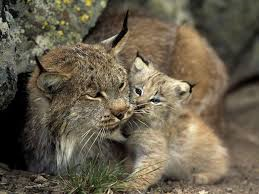
June 19, 2014
Service Announces Draft Economic Analysis, Draft Environmental Assessment for Revised Canada Lynx Critical Habitat
Service Also Reopens Comment Period on Sept.26, 2013 Proposed Revised Designation of Critical Habitat; Comment Period Open Until July 21, 2014
Contacts: Steve Segin; (303)-236-4578; robert_segin@fws.gov
Jim Zelenak; (406)-449-5225 ext. 220; jim_zelenak@fws.gov
LAKEWOOD, Colo. – The U.S. Fish and Wildlife Service (Service) is announcing the availability of a Draft Economic Analysis (DEA) and a draft environmental assessment for the proposed revised designation of critical habitat for the Contiguous U.S. Distinct Population Segment (DPS) of the Canada lynx (Lynx canadensis) under the Endangered Species Act (ESA). Comments on an amended required determinations section of the proposal may also be made during this comment period.
The Service is also reopening the comment period on the September 26, 2013 proposed revised designation of critical habitat for the lynx DPS to allow all interested parties the opportunity to comment simultaneously on the revised proposed rule, the associated DEA, the draft environmental assessment, and the amended required determinations section. Comments previously submitted need not be resubmitted, as they will be fully considered in preparation of the final rule.
The proposal includes the revised boundary of the lynx DPS, which would ensure that all lynx in the contiguous United States are protected under the ESA. It identifies areas proposed for critical habitat based on where the best science indicates the habitat could support lynx populations over time. The Service determined that areas occupied by lynx populations currently and at the time lynx were listed under the ESA are sufficient to conserve the DPS; therefore, the proposed designation does not include areas not currently occupied by lynx populations.
“Lynx are such mobile and far-ranging predators that they frequently traverse great distances and inhospitable habitats in search of prey. Determining where protections are essential is critical to the effective long-term conservation of this charismatic cat,” said Michael Thabault, Assistant Regional Director for Ecological Services in the Mountain-Prairie Region.
The lynx was protected under the ESA in 2000, when it was listed as threatened throughout its range in the contiguous United States, due to the inadequacy, at that time, of existing regulatory mechanisms. The Service designated critical habitat for the species in 2006 and revised the designation in 2009 to include habitat in six northern states. The current proposal includes most of the areas designated in 2009, as well as additional private timber lands in northern Maine, and Bureau of Land Management and National Park Service lands in northwestern Wyoming.
The DEA focused on economic impacts to areas where incremental impacts are most likely to occur as a result of the proposed critical habitat designation. According to the DEA, incremental costs resulting from the critical habitat designation are unlikely to reach $100 million in a given year based on the number of anticipated consultations and per-consultation administrative and project modification costs. Because all proposed critical habitat is occupied by lynx populations and most has been designated as lynx critical habitat since 2009, section 7 consultation already occurs, and incremental costs are expected to be minimal and largely administrative.
The Service will open a 30-day public comment period until July 21, 2014, to allow the public to review the draft documents. All relevant information received from the public, government agencies, the scientific community, industry, or any other interested parties will be considered and addressed in the agency’s final identification of habitat essential to the species’ conservation.
Comments and information may be submitted to the Federal Register online through the Federal eRulemaking Portal at http://www.regulations.gov (follow the instructions for submitting comments and use Docket No. FWS–R6-ES-2013-0101) or via U.S. mail or hand delivery to Public Comments Processing, Attn: FWS–R6–ES–2013–0101; Division of Policy and Directives Management; U.S. Fish and Wildlife Service; 4401 N. Fairfax Drive, MS 2042–PDM; Arlington, VA 22203.
For more information on the proposal and the associated maps by state of the proposed revised critical habitat designation, please visit the Canada lynx webpage: http://www.fws.gov/mountain-prairie/species/mammals/lynx/index.htm.
The U.S. Fish and Wildlife Service works with others to conserve, protect, and enhance fish, wildlife, plants, and their habitats for the continuing benefit of the American people. For more information, visit www.fws.gov, or connect with us through any of these social media channels: